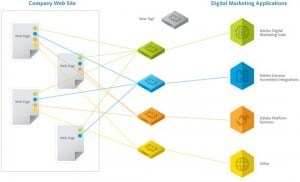Google Tag Manager the tool that will move the web analytics industry
Good news: Google has just launched Google Tag Manager (GTM), a tool that will allow you to manage all your web and marketing tags from a centralized web interface.
And since good news never comes alone, the agency is proud to announce that Adviso has been accredited as a “GTM Specialist” and is part of the first round of approval by Google.
The use of Google Tag Manager is free and in its launch version the tool is compatible with Google Analytics, AdWords, DoubleClick for Advertiser (DFA) and can support other solutions via custom fields.
BUT WHAT USE WILL IT BE FOR YOU?
Here are several good reasons to use Google Tag Manager:
- your website is complex,
- you use several tools related to web measurement (web analytics, online advertising, affiliation, remarketing, etc.),
- your IT resources are limited and/or expensive
- you are constantly improving your site and need flexibility.
If you recognize yourself in one of these situations, a tool like Google Tag Manager will help you.
WHAT ARE THE BENEFITS OF A TAG MANAGEMENT SYSTEM?
A tag management tool adds an intermediate layer between your website and your measurement tools, and offers you a web interface to implement/manage your tags.
Without tag management tool

-jpg.jpeg)
(Source: Adobe® TagManager)
So the 4 immediate benefits will be:
1- Postage from your technology department
After the first implementation, the first advantage of a tag management tool is to free you from your IT department and the imposed production dates. Thanks to a tag management interface, the web marketing team can gain autonomy and flexibility.
2- Better integration of your different marketing solutions
12.8% of commissions paid to a site's business contributors are duplicated ( Tag Man study ). Thanks to a tag management tool, you can define conditioned trigger rules to activate only the right conversion tags on the confirmation pages. In addition to solving conversion duplication issues , these rules also allow you to better define your marketing mix to go beyond the last-click conversion attribution model.
3- A reduction in the cost of installing/uninstalling a measurement tool
Whatever the number of measurement tools used on your site, thanks to Google Tag Manager, they will all be grouped together in the same “container” and their management will be done through a web interface. Thus it is much simpler and much less expensive to add/modify/delete tags on the pages of your site.
4- Improved site performance
Using a “container” that groups all the tags into a single block and using conditioning rules to indicate which tags to execute improves the loading time of your site's pages. A significant detail when you know that the loading time is a key factor for the user experience and will have a positive impact on SEO (it is a parameter of Google's algorithm) and the quality of the data collected.
THE STRENGTHS OF GOOGLE TAG MANAGER
In addition to the 4 advantages mentioned above, Google Tag Manager brings a few little extras compared to the solutions already available on the market:
- The use of a data layer which makes it possible to completely dissociate the data from the structure of the page. This will be very useful for a site that evolves often and/or for a site developed in agile mode.
- The ability to publish changes made to its container in real time. No more waiting, changes can be made immediately.
- The recording of the history of the different versions. This will have a double benefit. On the one hand, it is a support document that will be created dynamically and allow you to document the implementation made on the site. On the other hand it allows a quick backtrack if needed.
If you want to know more, here is the official Google documentation and/or you can contact us .
In the meantime, we look forward to an expansion of compatible solutions beyond the Google family.

-1.png)
-1.png)






